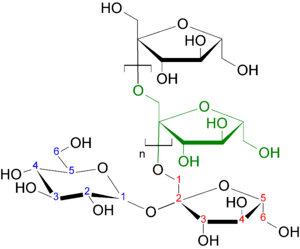Fructan

A fructan is a polymer of fructose molecules. Fructans with a short chain length are known as fructooligosaccharides. Fructans occur in foods such as agave, artichokes, asparagus, leeks, garlic, onions (including spring onions), yacón, jícama, and wheat.
Fructans also appear in grass, with dietary implications for horses and other grazing animals (Equidae).
Fructans may be associated with symptoms attributed to gluten-sensitivity by self-reporting non-celiac patients.[1]
Types
Fructans are built up of fructose residues, normally with a sucrose unit (i.e. a glucose-fructose disaccharide) at what would otherwise be the reducing terminus. The linkage position of the fructose residues determine the type of the fructan. Linkage normally occurs at one of the two primary hydroxyls (OH-1 or OH-6), and there are two basic types of simple fructan:
- 1-linked: In Inulin, the fructosyl residues are linked by β-2,1-linkages.
- 6-linked: In Levan (or Phlein), the fructosyl residues are linked by β-2,6-linkages.
A third type of fructans, the graminan-type, contains both β-2,1-linkages and β-2,6-linkages.[2]
More complex fructans are formed on a 6G-kestotriose backbone where elongations occur on both sides of the molecule. Again two types are discerned:
- neo-inulin type: pre- dominant β-2,1-linkages
- neo-levan type: pre- dominant β-2,6-linkages
Functions
Fructans are important storage polysaccharides in the stems of many species of grasses and confer a degree of freezing tolerance.[3][4] A notable exception is rice, which is unable to synthesise fructans.[5]
Fructan content of various foods
| Artichoke, Jerusalem | 16.0-20.0%[6] |
| Artichoke, Globe | 2.0-6.8%[6] |
| Asparagus | 1.4-4.1%[6] |
| Barley kernels (very young) | 22%[7] |
| Garlic | 17.4%[8] |
| Onion | 1.1-10.1%[6] |
| Rye (bran) | 7%[9] |
| Rye (grain) | 4.6-6.6%[9] |
| Wheat bread (white) | 0.7-2.8%[6] |
| Wheat flour | 1-4%[7] |
| Wheat pasta | 1-4%[6] |
See also
Notes
- ↑ Skodje, Gry I.; Sarna, Vikas K.; Minelle, Ingunn H.; Rolfsen, Kjersti L.; Muir, Jane G.; Gibson, Peter R.; Veierød, Marit B.; Henriksen, Christine; Lundin, Knut E.A. (2017). "Fructan, Rather Than Gluten, Induces Symptoms in Patients With Self-reported Non-celiac Gluten Sensitivity". Gastroenterology. 154 (3): 529–539.e2. doi:10.1053/j.gastro.2017.10.040. PMID 29102613.
- ↑ Van den Ende, Wim (2013). "Multifunctional fructans and raffinose family oligosaccharides". Frontiers in Plant Science. 4: 247. doi:10.3389/fpls.2013.00247. PMC 3713406. PMID 23882273.
- ↑ Pollock, C. J. (1986). "Tansley Review No. 5 Fructans and the Metabolism of Sucrose in Vascular Plants". New Phytologist. 104: 1–24. doi:10.1111/j.1469-8137.1986.tb00629.x.
- ↑ Pollock, C. J.; Cairns, A. J. (1991). "Fructan Metabolism in Grasses and Cereals". Annual Review of Plant Physiology and Plant Molecular Biology. 42: 77–101. doi:10.1146/annurev.pp.42.060191.000453.
- ↑ Kawakami, A.; Sato, Y.; Yoshida, M. (2008). "Genetic engineering of rice capable of synthesizing fructans and enhancing chilling tolerance". Journal of Experimental Botany. 59 (4): 793–802. doi:10.1093/jxb/erm367. PMID 18319240.
- 1 2 3 4 5 6 Shepherd, Susan J. (2006). "Fructose Malabsorption and Symptoms of Irritable Bowel Syndrome: Guidelines for Effective Dietary Management" (PDF). J Am Diet Assoc. 106 (10): 1631–1639. doi:10.1016/j.jada.2006.07.010. PMID 17000196.
- 1 2 Slavin, Joanne L. (2000). "Mechanisms for the Impact of Whole Grain Foods on Cancer Risk". Journal of the American College of Nutrition. 19 (90003): 300S–307S. doi:10.1080/07315724.2000.10718964.
- ↑ Muir, J.G.; et al. (2007). "Fructan and Free Fructose Content of Common Australian Vegetables and Fruit". Journal of Agricultural and Food Chemistry. 55 (16): 6619–6627. doi:10.1021/jf070623x. PMID 17625872.
- 1 2 Karppinen, Sirpa. Dietary fibre components of rye bran and their fermentation in vitro. Espoo 2003. VTT Publications 500. 96 p. + app. 52 p.
References
- Sugar - Chemical, Biological and Nutritional Aspects of Sucrose. John Yudkin, Jack Edelman and Leslie Hough (1971, 1973). The Butterworth Group. ISBN 0-408-70172-2